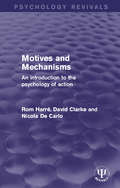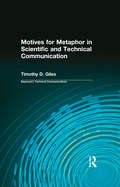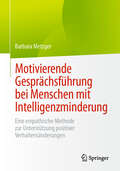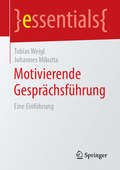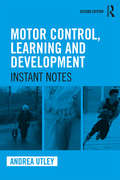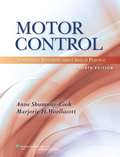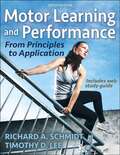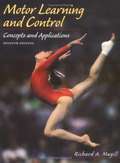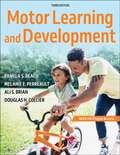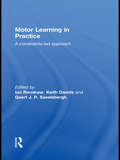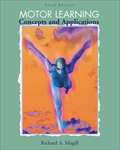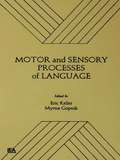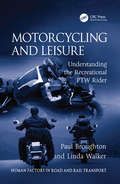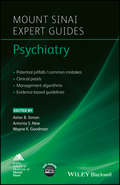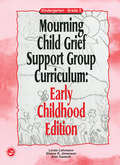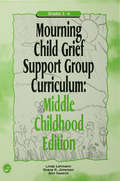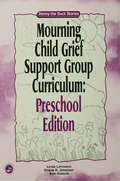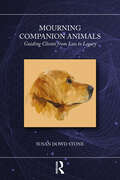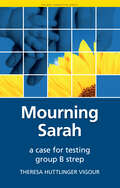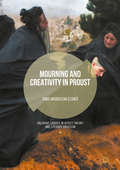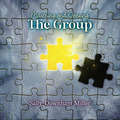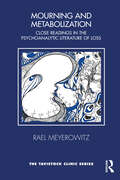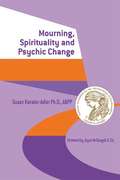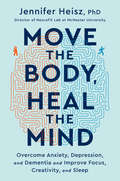- Table View
- List View
Motives and Mechanisms: An Introduction to the Psychology of Action (Psychology Revivals)
by David Clarke Rom Harré Nicola De CarloAs the first introductory statement of the ‘new psychology’, Motives and Mechanisms, originally published in 1985, aims to bring the study of human action to the forefront of the subject. Like any science, the practice of psychology is very much influenced by the hidden assumptions of its practitioners. The argument put forward in this important text shows how these assumptions can be brought out by comparing psychology with the natural sciences and with common-sense understanding. In pursuing the integration of traditional research methods with a new style of investigation, the basic principle is that social structures and mental structures are in reciprocal relation with one another because each is involved in the creation of the other. By adopting this principle social structures become the basis for research into the cognitive and emotional organization of mind. The authors devote two key chapters to the central question that underlies this stance: are human actions and human actors’ products of internal processes, such as those described by Freud, or of external social forces, of the kind described by Mead?
Motives for Metaphor in Scientific and Technical Communication: Large Type Edition (Baywood's Technical Communications)
by Charles H Sides Timothy D GilesExamination of the work of scientific icons-Newton, Descartes, and others-reveals the metaphors and analogies that directed their research and explain their discoveries. Today, scientists tend to balk at the idea of their writing as rhetorical, much less metaphorical. How did this schism over metaphor occur in the scientific community? To establish that scientists should use metaphors to explain science to the public and need to be conscious of how metaphor can be useful to their research, this book examines the controversy over cloning and the lack of a metaphor to explain it to a public fearful of science's power.The disjunction between metaphor and science is traced to the dispensation of the Solar System Analogy in favor of a mathematical model. Arguing that mathematics is metaphorical, the author supports the idea of all language as metaphorical-unlike many rhetoricians and philosophers of science who have proclaimed all language as metaphorical but have allowed a distinction between a metaphorical use of language and a literal use.For technical communication pedagogy, the implications of this study suggest foregrounding metaphor in textbooks and in the classroom. Though many technical communication textbooks recommend metaphor as a rhetorical strategy, some advise avoiding it, and those that recommend it usually do so in a paragraph or two, with little direction for students on how to recognize metaphors or to how use them. This book provides the impetus for a change in the pedagogical approach to metaphor as a rhetorical tool with epistemological significance.
Motives in Children's Development: Cultural-historical Approaches
by Anne Edwards Marilyn Fleer Mariane HedegaardThe contributors to this collection employ the analytic resources of cultural-historical theory to examine the relationship between childhood and children's development under different societal conditions. In particular they attend to relationships between development, emotions, motives and identities, and the social practices in which children and young people may be learners. These practices are knowledge-laden, imbued with cultural values and emotionally freighted by those who already act in them. The book first discusses the organising principles that underpin a cultural-historical understanding of motives, development and learning. The second section foregrounds children's lives to exemplify the implications of these ideas as they are played out - examining how children are positioned as learners in pre-school, primary school and play environments. The final section uses the core ideas to look at the implementation of policy aimed at enhancing children's engagement with opportunities for learning, by discussing motives in the organisations that shape children's development.
Motivierende Gesprächsführung bei Menschen mit Intelligenzminderung: Eine empathische Methode zur Unterstützung positiver Verhaltensänderungen
by Barbara MetzgerMenschen mit Intelligenzminderung stehen häufig vor besonderen Herausforderungen – sei es in ihrer Lebensgestaltung, in der Kommunikation oder im Umgang mit gesundheitlichen und sozialen Schwierigkeiten. Zugleich fehlt es häufig an geeigneten beraterischen und therapeutischen Konzepten, die auf ihre besonderen Bedürfnisse ausgerichtet sind. Dieses Fachbuch zeigt, wie die bewährte Methode der Motivierenden Gesprächsführung (Motivational Interviewing) speziell für diesen Personenkreis angepasst werden kann. Schritt für Schritt wird beschrieben, wie durch Empathie, Akzeptanz und gezielte Kommunikationsstrategien Veränderungsmotivation geweckt und nachhaltige Fortschritte erreicht werden können – und das ohne Druck und Zwang. Mit anschaulichen Ablaufplänen, Fallbeispielen, praxiserprobten Gesprächsmethoden und wissenschaftlich fundierten Hintergrundinformationen richtet sich dieses Buch an Fachkräfte, Angehörige und alle, die Menschen mit Intelligenzminderung auf ihrem Weg zu mehr Selbstbestimmung und Lebensqualität begleiten möchten. Ein wertvoller Leitfaden für eine respektvolle und erfolgreiche Unterstützung positiver Veränderungen.
Motivierende Gesprächsführung: Eine Einführung (essentials)
by Tobias Weigl Johannes MikuttaDie Autoren stellen in diesem essential Grundlagen und Hintergründe der Motivierenden Gesprächsführung dar und liefern dem Leser damit das nötige Wissen, um mit der anwendungsorientierten Vertiefung des Ansatzes beginnen zu können. Anhand von Beispielen werden zudem erste Anregungen zur Umsetzung geboten. Die Autoren sprechen damit Studierende und Praktiker verschiedener Gesundheitsberufe und Teilnehmer in psychotherapeutischer Weiterbildung gleichermaßen an.
Motor Control, Learning and Development: Instant Notes, 2nd Edition (Instant Notes)
by Andrea UtleyAn understanding of the scientific principles underpinning the learning and execution of fundamental and skilled movements is of central importance in disciplines across the sport and exercise sciences. The second edition of Motor Control, Learning and Development: Instant Notes offers students an accessible, clear and concise introduction to the core concepts of motor behavior, from learning through to developing expertise. Including two brand new chapters on implicit versus explicit learning and motor control and aging, this new edition is fully revised and updated, and covers: definitions, theories and measurements of motor control; information processing, neurological issues and sensory factors in control; theories and stages of motor learning; memory and feedback; the development of fundamental movement skills; and the application of theory to coaching and rehabilitation practice. Highly illustrated and well-formatted, the book allows readers to grasp complex ideas quickly, through learning objectives, research highlights, review questions and activities, and encourages students to deepen their understanding through further reading suggestions. This is important foundational reading for any student taking classes in motor control, learning or behavior or skill acquisition, or a clear and concise reference for any practicing sports coach, physical education teacher or rehabilitation specialist.
Motor Control: Translating Research into Clinical Practice (4th Edition)
by Anne Shumway Cook Marjorie H. WoollacottThis book tries to reduce the gap between research and clinical practice that is created as a result of explosion of new research in the field of neuroscience and motor control.
Motor Learning And Performance: From Principles To Application
by Richard A. Schmidt Timothy D. LeeMotor Learning and Performance: From Principles to Application, Sixth Edition With Web Study Guide, enables students to appreciate high-level skilled activity and understand how such incredible performances occur. Written in a style that is accessible even to students with little or no knowledge of physiology, psychology, statistical methods, or other basic sciences, this text constructs a conceptual model of factors that influence motor performance, outlines how motor skills are acquired and retained with practice, and shows students how to apply the concepts to a variety of real-world settings. The sixth edition of Motor Learning and Performance has been carefully revised to incorporate the most important research findings in the field, and it is supplemented with practice situations to facilitate a stronger link between research-based principles and practical applications. Other highlights include the following: A web study guide offers updated principles-to-application exercises and additional interactive activities for each chapter, ensuring that students will be able to transfer core content from the book to various applied settings. Extensive updates and new material related to the performance of complex movements expand the theoretical focus to a more in-depth analysis of dynamical systems and the constraints-led approach to learning. Narratives from Motor Control in Everyday Actions that appear in the web study guide tie each book chapter to concrete examples of how motor behavior is applicable to real life. Photo caption activities pose questions to students to encourage critical thinking, and answers to those questions are provided to instructors in the instructor guide. As the text investigates the principles of human performance, pedagogical aids such as learning objectives, key terms, and Check Your Understanding questions help students stay on track with learning in each chapter. Focus on Research and Focus on Application sidebars deliver more detailed research information and make connections to real-world applications in areas such as teaching, coaching, and therapy. The sixth edition of Motor Learning and Performance: From Principles to Application goes beyond simply presenting research—it challenges students to grasp the fundamental concepts of motor performance and learning and then go a step further by applying the concepts. Incorporating familiar scenarios brings the material to life for students, leading to better retention and greater interest in practical application of motor performance and learning in their everyday lives and future careers.
Motor Learning and Control: Concepts and Applications 7th Edition
by Richard A. MagillOffers an introduction to motor learning and motor control for students who aspire to be¬come practitioners in a variety of professions.
Motor Learning and Development
by Pamela S. Beach Melanie Perreault Ali Brian Douglas H. CollierDifferent from any other motor behavior text on the market, Motor Learning and Development, Third Edition With HKPropel Access, combines two subdisciplines of motor behavior in an accessible and easy-to-follow manner. By uniting these two disciplines under the same cover, the text prepares students to create, apply, and evaluate motor skill programs for people of all skill and development levels. <p><p>Motor Learning and Development, Third Edition, outlines the fundamental concepts of both motor learning and motor development. It explores movement patterns across all ages throughout the human life span, including the influences of life transitions and individual and sociocultural constraints. The text provides a complete framework for students to consider the many variables for each individual and then create and implement developmentally appropriate movement programs. <p><p>The third edition has been revised and updated with current research and examples, and it includes the following enhancements: <p>•Expanded coverage of fundamental movement skills and skill classification <p>•Four new chapters exploring the assessment of gross motor development, sociocultural constraints, developmental models for instruction, and program design <p>•Additional videos illustrating fundamental motor skills, motor milestones, and infant reflexes <p>•New supplemental activities at the end of each chapter prompting students to apply concepts from the text to their own life experience <p><p>Motor Learning and Development, Third Edition, also has related online activities and video clips designed to encourage critical thinking and application of concepts. Lab activities, which can be assigned by instructors in HKPropel, require students to complete hands-on assignments and draw conclusions. Over 90 videos demonstrate people of various ages, including infants, completing motor tasks so students can observe and assess movements throughout the life span firsthand. <p><p>Other learning aids within the book include chapter objectives, glossary terms, sidebars, and supplemental activities to emphasize the evolution from research to practice. Opening vignettes in each chapter demonstrate the breadth of professions that use research in motor behavior. <p><p>Motor Learning and Development, Third Edition, offers a foundation for understanding how humans acquire and continue to develop their movement skills throughout the life span.
Motor Learning in Practice: A Constraints-Led Approach
by Ian RenshawMotor Learning in Practice explores the fundamental processes of motor learning and skill acquisition in sport, and explains how a constraints-led approach can be used to design more effective learning environments for sports practice and performance. Drawing on ecological psychology, the book examines the interaction of personal, environmental and task-specific constraints in the development of motor skills, and then demonstrates how an understanding of those constraints can be applied in a wide range of specific sports and physical activities. The first section of the book contains two chapters that offer an overview of the key theoretical concepts that underpin the constraints-led approach. These chapters also examine the development of fundamental movement skills in children, and survey the most important instructional strategies that can be used to develop motor skills in sport. The second section of the book contains eighteen chapters that apply these principles to specific sports, including basketball, football, boxing, athletics field events and swimming. This is the first book to apply the theory of a constraints-led approach to training and learning techniques in sport. Including contributions from many of the world’s leading scholars in the field of motor learning and development, this book is essential reading for any advanced student, researcher or teacher with an interest in motor skills, sport psychology, sport pedagogy, coaching or physical education.
Motor Learning: Concepts and Applications, 6th edition
by Richard A. MagillCovers all the basics from both a motor program view as well as a dynamic systems view.
Motor and Sensory Processes of Language (Neuropsychology and Neurolinguistics Series)
by Eric Keller Myrna GopnikPublished in 1987, Motor and Sensory Processes of Language is a valuable contribution to the field of Cognitive Psychology.
Motorcycling and Leisure: Understanding the Recreational PTW Rider (Human Factors in Road and Rail Transport)
by Paul Broughton Linda WalkerDespite the fact that there are around 1.2 million powered two wheelers (PTWs) within the United Kingdom, riders are often misconceived as living at the edge of society; however, this is often far from the truth. Riding a PTW is a high-risk activity and those who ride are often perceived as being 'risk junkies', but through an in-depth exploration of this leisure activity, Motorcycling and Leisure explains that riders ride because they enjoy it and do not necessarily enjoy the risk involved. The book presents a range of contemporary research on riders and how they find enjoyment. The book further explores the rider goal of enjoyment and utilises Fuller's task homeostasis theory along with Csikszentmihalyi's theory of flow to develop an understanding of the interaction between risk and goals. In conclusion it develops principles of interventions with the aim of guiding intervention design and reducing the number of motorcycle crashes.
Mount Sinai Expert Guides: Psychiatry
by Antonia S. New Asher B. Simon Wayne K. GoodmanThe Mount Sinai Expert Guides, published by Wiley and endorsed by Mount Sinai School of Medicine in New York, provide rapid access, point-of-care clinical information on the most common diseases in a range of different therapeutic areas. Each title focuses on a different speciality and emphasis throughout is on providing rapid-access, clear clinical guidance to aid physicians with point-of-care management of their patients. Each title is edited by a renowned specialist from Mount Sinai, normally the Chair of the department, who is responsible for recruiting key faculty members to author the chapters. A chapter template has been developed to which each chapter author must adhere, so as to ensure complete consistency across all the chapters in each book and also across every book in the series. Accompanying each book is a companion website containing accessory materials such as case studies, video clips, MCQs, patient advice and PQRI/ICD codes. Mount Sinai Expert Guides: Psychiatry will provide specialist trainees and recently qualified specialists in psychiatry with an extremely clinical, affordable and accessible handbook covering the specialty. It will be used as both a point-of-care resource in the hospital and clinical setting, and also as a refresher guide during preparation for board exams and re-certification. Focused on providing 100% clinical guidance on the most common conditions that psychologists encounter, it will present the very best in expert information in an attractive, easy to navigate informative and well-structured manner, with features such as key points, potential pitfalls, management algorithms, and national/international guidelines on treatment.
Mourning Child Grief Support Group Curriculum: Early Childhood Edition: Kindergarten - Grade 2
by Shane R. Jimerson Linda Lehmann Ann GaaschContains lesson plans for 10 sessions that include age-appropriate activities. These fun and engaging activities enable young children to approach highly sensitive and painful topics.
Mourning Child Grief Support Group Curriculum: Middle Childhood Edition: Grades 3-6
by Shane R. Jimerson Linda Lehmann Ann GaaschContains lesson plans for 10 sessions that include age-appropriate activities. These fun and engaging activities enable young children to approach highly sensitive and painful topics.
Mourning Child Grief Support Group Curriculum: Pre-School Edition: Denny the Duck Stories
by Shane R. Jimerson Linda Lehmann Ann GaaschThis volume encourages and enables children who might have limited language to work through their feelings through play.
Mourning Companion Animals: Guiding Clients from Loss to Legacy
by Susan Dowd StoneMourning Companion Animals is a guidebook for mental health clinicians searching for effective, compassionate resources to guide their clients through the often-devastating experience of animal companion loss.Chapters offer powerful and comprehensive strategies to heal animal companion loss based in sound, evidenced based, theoretical perspectives. The included author-generated inventory, the animal companion bereavement questionnaire, provides further assistance in clinician exploration of each client’s unique bond with their lost companion.The book’s content is the result of more than twenty-five of extensive work within the human-animal bond, clinical training in the referenced therapies, and application of major psychodynamic theories.
Mourning Sarah
by Theresa Huttlinger Vigour‘In this astonishing read, we follow Vigour's journey into darkness and loss, a gripping pilgrimage that leads to eventual knowledge and empowerment. This lucid book should be required reading for any woman headed to the maternity ward. This unforgettable book reveals what would have happened to my son and family had he not been treated for group B strep at birth. Let's celebrate Vigour's brave testimony here and take heed of her hard-won insights on the medical establishment that surrounds the birth experience.’ Paul Morris, Director, Master of Liberal Studies Program, Arizona State University, USA ‘A tragic story, clearly told. Theresa shares the confusion, pain and devastation she and her family experienced around the time of her daughter, Sarah's, birth and early death from potentially preventable group B Strep infection. Many who have suffered similar losses will draw comfort from this book, knowing that they aren't alone. Thankfully, as Theresa outlines, measures are now in place in the US that ensure most group B strep infections in babies are prevented there – in the UK, we're yet to achieve this, though we continue to campaign for such measures to be introduced. Perhaps were the decision makers to read this book, it would happen sooner - I fervently hope so.’ Jane Plumb, Chairman, Group B Strep Support, UK ‘Mourning Sarah is filled with important, even urgent, messages for any woman having a baby right here, right now, and for all young girls who soon will grow into womanhood and want babies of their own. Theresa Vigour articulates the unspeakable loss of her daughter using every hue in the emotional rainbow. Her account is exquisite, her metaphors masterful, and throughout the book, she skilfully weaves her inner and outer worlds. Theresa Vigour has given us a gift.’ Lorraine Ash in her Foreword 'Deep was the grief that came with the death of Theresa Vigour's newborn daughter, Sarah. Yet profound is this memoir of her mother's journey. It is a gift to see such raw and visceral emotion transformed into beautiful and evocative prose that touch and teach and heal.' Walt Harrington, author of The Everlasting Stream
Mourning and Creativity in Proust
by Anna Magdalena ElsnerThis study explores Proust's answers to some of the fundamental challenges of the inevitable human experience of mourning. Thinking mourning and creativity together allows for a fresh approach to the modernist novel at large, but also calls for a reassessment of the particular historical and social challenges faced by mourners at the beginning of the twentieth century. The book enables the reader to acknowledge loss and forgetting as an essential part of memory, and it proposes that this literary topos has seminal implications for an understanding of the ethics, aesthetics, and erotic in Proust's A la recherche du temps perdu. Drawing on the works of Sigmund Freud and Jacques Derrida, Anna Magdalena Elsner develops an original theory of how mourning and creativity are linked by emphasizing that ethical dilemmas are central to an understanding of the novel's final aesthetic apotheosis. This sheds new light on the enigmatic and versatile nature of mourning but also pays tribute to those fertile tensions and paradoxes that have made Proust's novel captivating for readers since its publication.
Mourning and Dancing: A Curriculum for Grief Support Groups
by Sally Downham MillerGrief. Whether through the death of a loved one, a shattering divorce, a mass tragedy, or other life-altering loss, grief is a common experience of humankind. When Sally Miller became a 24-year-old widow with two young children, she did not know where to turn. Confused, angry, and devastated, she soon realized that she was not alone, that many others had comparable responses to their different losses. And that talking with each other helped. This led her to develop a Grief Support Group. Decades later, using Sally's topics and experience, many similar groups are located around the country, where anyone who is grieving can find techniques and tools, friendship and support, no matter what their age or circumstance. Mourning and Dancing: The Group offers a valuable curriculum to help others set up a group in their community that will enable grieving people to begin their journey toward healing through proven methods and suggestions on how to deal with the realities of grief while shaping positive thought processes that can carry them into the days and years to come.
Mourning and Metabolization: Close Readings in the Psychoanalytic Literature of Loss (Tavistock Clinic Series)
by Rael MeyerowitzBy bringing together perspectives from psychoanalysis and literary studies and considering the reciprocal relation between ideas about mourning and our internal worlds, this book provides a guide to thinking theoretically about loss and how we deal with it. Rael Meyerowitz conceptualizes the work of psychic internalization required by loss in terms of bodily digestion and metabolization. In this way, successful mourning can be likened to the proper processing of physical sustenance, while failed mourning is akin to indigestion, as expressed in various forms of melancholia, mania, depression, and anxiety. Borrowing from the methodology of literary criticism, the book conducts a detailed treatment of these themes by drawing on a series of psychoanalytic works, including those of Freud, Ferenczi, Karl Abraham, Klein, Loewald, Torok, Nicolas Abraham, and Green, while paying close critical attention to a selection of literary works such as those by William Faulkner, Wallace Stevens, and Sylvia Plath. Aimed at clinicians as well as readers with a more academic interest in psychoanalytic theory and language, the close-reading format offered by this book will also enable students in psychoanalytic and psychotherapy courses to engage deeply with some central texts and key concepts in psychoanalysis.
Mourning, Spirituality and Psychic Change: A New Object Relations View of Psychoanalysis
by Susan Kavaler-AdlerIn her earlier books, Susan Kavaler-Adler identified healthy mourning for traumas and life changes as an essential aspect of successful analysis, and drew the distinction between a healthy acceptance of mourning as part of development and pathological mourning, which 'fixes' a patient at an unhealthy stage of development.This new book brings such distinctions into the consulting room, exploring how a successful analyst can help patients to utilise mourning for past troubles to move them forward to a lasting change for the better, emotionally, psychically and erotically. The author also tackles the controversial issue of spirituality in psychoanalysis, and explores how psychoanalysis can help patients come to terms with difficult issues in a time of great psychic and spiritual disturbance. These themes are brought to life via two richly detailed case studies.
Move The Body, Heal The Mind: Overcome Anxiety, Depression, and Dementia and Improve Focus, Creativity, and Sleep
by Jennifer HeiszA noted neuroscientist reveals groundbreaking research on how fitness and exercise can combat mental health conditions such as anxiety, dementia, ADHD, and depression, and offers a plan for improving focus, creativity, and sleep.Jennifer Heisz shares paradigm-shifting research on how exercise affects the brain, finding that intervals of intense workouts, or even leisurely walks, help stop depression and dementia, lessen anxiety and ADHD, and encourage better sleep, creativity, and resilience. Physical inactivity is the greatest risk factor contributing to dementia and anxiety—it’s as much a factor as genetics. In addition, exercise’s anti-inflammatory properties make it the most effective treatment strategy for those who are depressed and don’t respond to anti-depressants. The book focuses on overcoming inertia; using exercise to help fight addictions; how we can improve our memory with fitness even as we age; and, importantly, how exercise can help us sleep better, improve focus, and be more creative. Included are easy to use plans for unique aerobic and resistance workouts designed to strengthen the brain.
